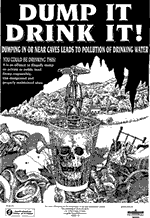 From
time to time, the SUI produces reports and informative articles of use to
cavers and the general public.
From
time to time, the SUI produces reports and informative articles of use to
cavers and the general public.
These are published on this page.
Report 1. October 1996
Dump
it, Drink it. 
A campaign which included a leaflet and superb poster by Joe
Walls and supported by the Department of the Environment to highlight the
adverse affects of dumping in caves.
Introduction
Ireland has traditionally been thought of as having plenty of uncontaminated water supply. However, the karstic areas have always been problematic because of the lack of surface water and the high proportion of failed wells due to the localisation of flow in cave systems. Increasingly, another problem is being added to the difficulties of supply being faced by thousands of Irish Families and households who depend on ground water - water quality.
The problems of polluted water are perhaps more obvious to the caver than to the general public who more often than not accept what is coming out of the ground as pure and unrelated to what happens at the surface or what disappears underground. Most people are unaware that sinking water rapidly travels and can rise again many kilometers away in a matter of hours or days, moving through fissures or cave passages. Such flow routes generally offer little or no filtration or purification and so water supplies in karst areas are highly vulnerable to pollution.
Where does this contamination come from?
There are three sources
of water contamination in cave areas; septic tanks, dumping and agricultural
activities. In those areas in the West of Ireland for example, where drinking
water is vulnerable to pollution approximately 650,000m3 of septic tank effluent
is discharged underground each year (1989 figures). Septic tanks act primarily
as settlement chambers and do not reduce the polluting power of the effluent
significantly. In virtually all cases the effluent leaving the tank is discharged
into the ground via a soak pit* rather than a pipe distribution system. Soak
pits tend to be deep, often penetrating the thin layer of soil and discharging
directly into the rock. This rapidly enters the water table from where wells
draw water.
*Pipe distribution, on the other hand, tends to maximise the
absorption of the overlying soil and thus makes it more efficient in treatment.
Although the levels of agricultural activity in caving areas is generally low, there sometimes can be severe problems due to the inadequate management of agricultural wastes. The main sources of pollution are manure, slurry, farmyard run-off and silage effluent. The increased tendency to over winter in farmyards has tended to centralise wastes in small areas with consequent problems of waste control and disposal. The dumping of rubbish which has been found to include babies nappies, batteries, chemicals, rat poison, weed killers and dead farm stock has also been found close to or at cave entrances. All of which will contaminate the ground water and……..
You could be drinking this !
What can you do?
More often than not, the water you drink is shared by others in the same catchment area. In such cases, if you suspect contamination, contact your local county council. They should have the capacity to track water flow in the area and analyze the quality. Protecting your community ground water supply from contamination can be accomplished by completing a 5-step protection process:
1. Form a community planning
team
2. Define the land
catchment area to be protected
3. Identify and locate potential contaminants (sewerage, slurry, chemicals
etc.)
4. Manage the protection area with the help of your county council Environmental
officer.
5. Plan for the future (community sewerage schemes, waste treatment etc.)
If you suspect dumping, or come across an illegal dumping ground contact your county council with a view to getting it cleaned up.
Illegal dumping can lead to heavy fines and prison sentencing.
This report has been
produced by the Speleological Union of Ireland which represents the interests
of cavers throughout the country out of interest to protect our environment
with financial support from the Department of the Environment.
This article was adopted from Richard Thorn and Catherine Coxon's paper titled 'Groundwater Quality in Karst Areas of Ireland' which was published in Irish Speleology No. 13 1989.